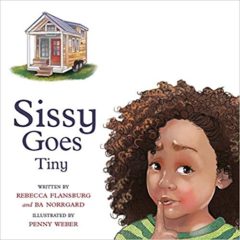Sissy Goes Tiny

Sissy Goes Tiny
Written by Rebecca Flansburg and Ba Norrgard
Illustrated by Penny Weber
Published by AudreyPress
This delightful book follows a family transitioning to Tiny House living, a trend that is becoming increasingly popular. The book opens with Sissy feeling gratitude for her big bed, big bedroom, her backyard with big trees, her house, her family and her life. But Sissy’s parents decide to live Tiny. The parents read a book about living in Tiny houses with Sissy and give her some details about their new life. They explain that their new house will be on wheels so they will be free to travel wherever they want, and the world will be their backyard to explore. Her parents tell her, “Living Tiny means we can own Fewer things and have More experiences.” Sissy’s parents explain that they will have to do “…what’s called a possession purge.”
When her parents first tell Sissy about their new Tiny life, she naturally feels a bit sad and scared about giving up some of these things that she loves. She sees that giving up things is difficult for her parents too. They all keep in mind what her father said to Sissy, “The more stuff you own, the more your stuff owns you.” When Sissy gives away some of her possessions, she realizes that she is helping others less fortunate than her. This makes it easier for her to give up her possessions.
Sissy realizes that she can keep things that are most special and preserve her memories. Some friends who are already living Tiny come by and show Sissy how she can repurpose some of her most prized possessions to be used in her Tiny house. For instance, the apron her grandmother gave her would become a curtain for her new bedroom. Sissy and her family also take photos of their house and special places in their town to make a Memory Book. When their Tiny House arrives, Sissy is ready and excited to start her new adventures in life.
The themes addressed in the story are common in childhood – dealing with change and the unknown, how to be grateful, having compassion, helping others, and learning from parents as role models – and are dealt with realistically. The overarching theme of the book is dealing with change. It can be scary and sad, but also exciting and fun and the authors handle both sides well. For instance, When the Tiny house arrives, Sissy is thrilled to start Tiny living and explore new places.
This book is diverse in several ways. Sissy is a child of a mixed-race family. In addition, the family is making a change to an alternative way of living. The illustrations are warm, familiar and realistic. They help create the feel-good mood of this book. The growing popularity of Tiny living makes the story quite timely and relevant. Sissy Goes Tiny is a marvelous tool to open discussions about change, gratitude, helping others and the importance of experiences over possessions. This book is highly recommended for children ages 4-8.
A hardcover copy of this book was donated to me by Rebecca Flansburg, one of the authors to review for the Multicultural Children’s Book Day 2020 event (1/31/20)”
Multicultural Children’s Book Day 2020 (1/31/20) is in its 7th year! This non-profit children’s literacy initiative was founded by Valarie Budayr and Mia Wenjen; two diverse book-loving moms who saw a need to shine the spotlight on all of the multicultural books and authors on the market while also working to get those book into the hands of young readers and educators.
Seven years in, MCBD’s mission is to raise awareness of the ongoing need to include kids’ books that celebrate diversity in homes and school bookshelves continues.
Purchase Now